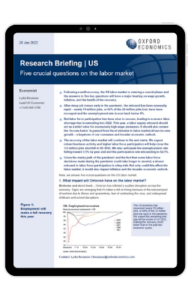Five crucial questions on the US labor market

Following a swift recovery, the US labor market is entering a crucial phase and the answers to five key questions will have a major bearing on wage growth, inflation, and the health of the recovery.
After steep job losses early in the pandemic, the rebound has been unusually rapid – nearly 19 million jobs, or 84% of the 22 million jobs lost, have been recouped and the unemployment rate is now back below 4%. But labor force participation has been slow to recover, leading to a severe labor shortage that is extending into 2022.
This year, a labor supply rebound should act as a relief valve for excessively high wage pressures. It should also ensure the ‘income baton’ is passed from fiscal stimulus to labor market-driven income growth – a keystone of our consumer and broader economic outlook.
The recovery of the labor market will continue in fits and starts. We expect robust business activity and higher labor force participation will help close the 3.6 million jobs shortfall in H2 2022. We also anticipate the unemployment rate falling toward 3.5% by year-end and the participation rate rebounding to 62.5%.
Given the murky path of the pandemic and the fact that some labor force decisions made during the pandemic could take longer to unwind, a slower rebound in labor force participation is a key risk. Not only could this affect the labor market; it would also impact inflation and the broader economic outlook.
Read the report for full answers to the five crucial questions on the US labor market:
- What impact will Omicron have on the labor market?
- How tight is the labor market?
- Will labor force participation rebound?
- Will wage growth stay hot?
- How close are we to ‘full employment’?
Tags:
Related Research

Post
Eurozone: Little sign of harm from the Red Sea disruptions
The impact of Red Sea shipping disruption on the eurozone economy continues to be limited, in line with our baseline view. Our new Eurozone Supply Stress Indicator suggests that supply pressures have returned to normal following a period of easing in 2023.
Find Out More
Post
GCC: Key themes shaping city economies in the near term
For Gulf cities, the near-term outlook will be tied not only to the global macroeconomic backdrop, but also the progress of the diverse visions and strategies in the region. With the aim to diversify their economies and reduce the dependence on oil, Gulf states continue to invest in the non-oil economy and implement various reforms. That said, oil revenues remain key to funding diversification efforts.
Find Out More
Post
Indonesia rate cuts will bolster credit demand, with pockets of risks
We forecast Bank Indonesia will start cutting its policy rate in Q2, which will provide a cyclical tailwind for credit growth and consequently domestic demand, as lower real lending rates will help boost loan demand.
Find Out More